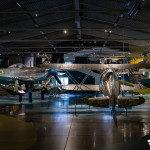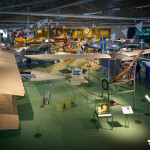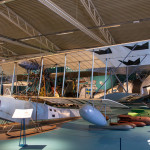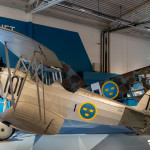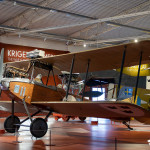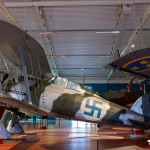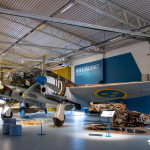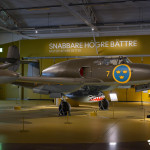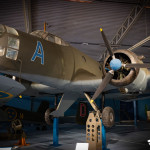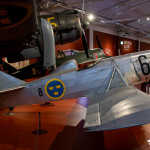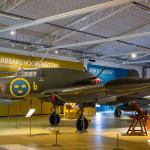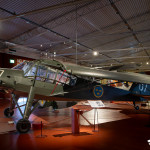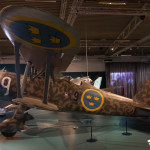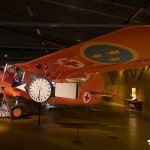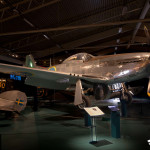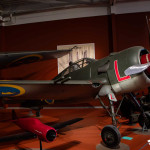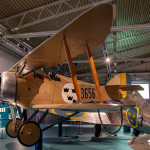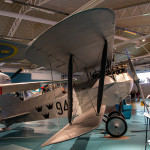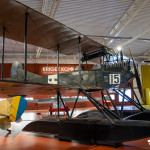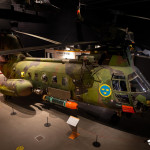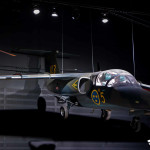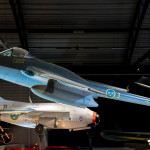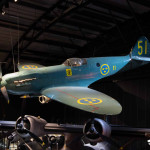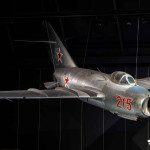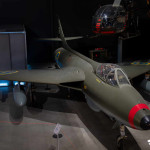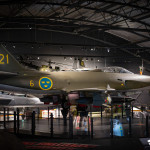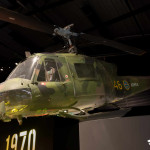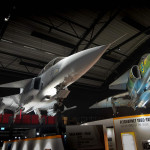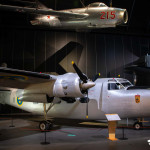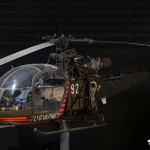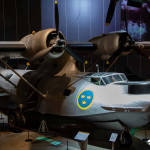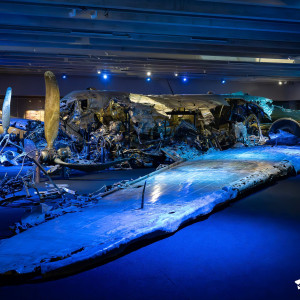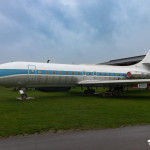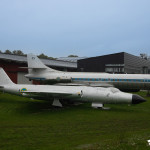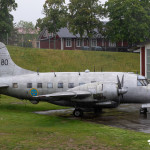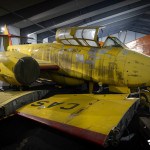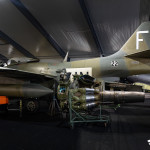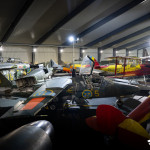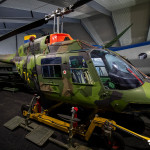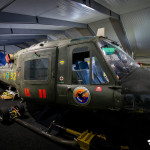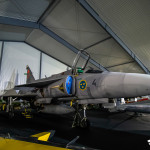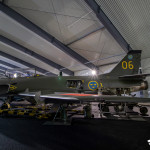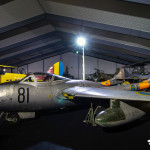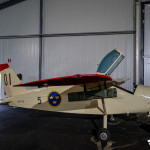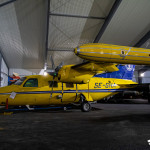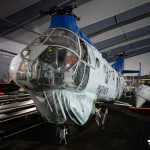Flygvapenmuseum – Swedish Air Force Museum
Article originally published by Aviation News in March 2024
Situated on the historic and active Malmen Air Base in Malmslätt, the Flygvapenmuseum is the official museum of the Swedish Air Force. Malmen now serves as the base for the Swedish Armed Forces Helicopter Wing and the Air Force Flying School, at the time of our visit there were a number of Saab SK. 60 in the circuit flying sorties ahead of the impending retirement of the type.
The museum is part of the National Swedish Museums of Military History (SFHM) and houses a unique collection of military aircraft and other objects with connections to the century-long history of Swedish aviation.
The Army Aviation Company was stationed at Malmen between 1916 and 1926, this was followed by the Third Air Corps from 1926 to 1936, and later the Royal Östgöta Air Wing, F 3, which remained until 1974. During the early part of the 20th century two Wing Commanders at Royal Östgöta Air Wing, Colonel Gösta von Porat and Colonel Hugo Beckhammar, put in place the beginnings of the current museum by obtaining permission to allow for the preservation of some decommissioned Swedish Air Force aircraft in one of the base barracks. When it opened in 1951, the F 3 wing museum began with 11 preserved aircraft.
Over the years the collection of aircraft continued to grow and during 1977 the municipality of Linköping funded and built a new hangar in Ryd. The Östergötland Aviation Historical Society (ÖFS), that was founded ten years earlier continued to contribute to the maintenance and preservation of the collection’s aircraft and the operation of the museum. The Air Force Museum was then formally established and was incorporated into SFHM. The following year, a decision was made to build a brand-new museum building on the present site of the museum today. Construction began during the winter of 1982, and the new museum building was completed and formally opened two years later. During 1989, a further new museum hall was added.
In 2010,the museum was reopened after further period of refurbishment with several additional buildings and new purpose-built facilities for a restaurant, archive room and library to consolidate as many of the museum’s artifacts in one location. New exhibitions were introduced depicting the history of Swedish military aviation, from the pioneer era through the decades of the Cold War, when the Swedish Air Force was considered one of the world’s strongest, through to modern day aviation.
The museum collection in 2023 comprised over 240 aircraft and 44 helicopters either on display, in store or loaned to other collections throughout Sweden and Europe, together with over 65,000 individual artifact items including aircraft spare parts, vehicles, engines, uniforms and many other items related to the history of the Swedish Air Force.
On entering the museum, there are two main halls containing aircraft plus a basement area. The Airborne exhibition hall is the largest and presents Swedish military aviation in the first half of the 20th century, from its first pioneers and the establishment of the air force through to the advent of jet aircraft. Walking through the hall, the aircraft are portrayed in themes in chronological order starting with earliest aircraft through titled areas of the art of flight, in times of war & peace and flight safety taking the visitor up to the post war area.
This area contains a large number of locally produced and operated aircraft such as the Saab J.21 propellor and jet versions, Seversky EP-106 (J29), CVM O1 Tummelisa, and British built Hawker Hart and Gloster Gladiator. One particularly interesting and extremely rare aircraft preserved is sole surviving example of the Junkers Ju.86. Despite a number of aircraft being built under licence in Sweden the preserved aircraft was built in Germany as a Ju.86K model and sold to Sweden in 1938, where it served with the Swedish Air Force until retirement in 1958.
Moving to the next hall, named In Case of War, depicting the aircraft operated during a time when the world was characterised by the tensions between the East and the West and a time when Sweden invested heavily in its own defence. The aircraft are displayed in small, grouped areas of The 50’s, The 60’s, The 70’s and The 80’s with a number suspended from the ceiling and walls as well as the hall floor.
Aircraft such as the Saab 210 ‘Lildraken’, WSK-Mielec Lim-2, J28A Vampire, Hunting Percival P.66 Pembroke C.52 (Tp83) and Boeing-Vertol 107-II-15 (Hkp4B) plus other operated helicopters can be found on display alongside more modern jets such as SAAB Gripen JAS-39B and SAAB Viggen AJS-37.
The final display hall can be found in the basement and is titled Secret Documents – The DC-3 that disappeared. In 2005, the Air Force Museum was tasked by the Swedish government with preserving the wreckage of the DC-3, TP 79001, which was shot down by Soviet fighter aircraft over the Baltic Sea in 1952. On 13th June 1952, during the height of the cold war, the DC-3 departed from Bromma airport near Stockholm on an electronic intelligence gathering mission over the Baltic Sea. After being in the air for a few hours, communication with the aircraft was suddenly lost. No trace of the aircraft could be found apart from a few small items and traces of Soviet ammunition. A search for the missing aircraft was launched which resulted in a Consolidated Catalina being attacked by Soviet Mig-15 and forced to land. The Soviet Union denied any involvement in the loss until 1991. The wreckage was finally located in June 2003 and salvaged and the DC-3 was recovered and placed on display in the basement of the new museum hall with a very interesting timeline of the history of the aircraft and its final flight and ultimate loss.
A replacement for the lost aircraft was purchased in 1953 in the form of a single Vickers Varsity, designation Tp82 in Swedish service, and this aircraft (82001) also survives in preservation at the museum.
A number of larger aircraft such as the Vickers Varsity (Tp82), English Electric Canberra B.2 (Tp52), Douglas C-47A-25-DK, and Sud Aviation SE.210 Caravelle III are located outside in the museum grounds.
Alongside the museum is the small workshop area where the restoration of aircraft takes place. On the date of our visit this contained Grumman G-21 Goose, N79001 which although it never served with the Swedish Air Force on completion it will be painted to represent an aircraft of the Swedish Air Force. Outside of the workshop was a Saab J.29 Tunnen and Saab J35 Draken, the later has since been moved to the new aircraft hall on display suspended from the ceiling.
With the museum having a large number of aircraft in its inventory and care, only a smaller number can be displayed in the museum halls, the remainder being held at the museum storage site or on loan to other museum collections both in Sweden and throughout Europe. Located a short drive from the main museum and airfield, the storage site is located in a large hangar on a separate secure military site. At the time of our visit the hangar contained around 35 aircraft, helicopters and historical gliders. As the storage is location in a secure military area, it is not open to the general public to visit.
At the time of our visit on 25th August 2023 the following aircraft were on display and located in the storage area.
Airborne Exhibition Hall
| Registration | Type | Code/Markings |
| 2 | Caproni S.16 (Full Scale Model) | [10] |
| 4 | Albatros B.II (SK.1) | |
| 10 | Donnet-Leveque L.II | |
| 15 | Thulin G | |
| 80 | Schneider DFS 108-14 Schulgleiter SG-38 (Se101) | |
| 155 | Junkers JU-86K (B.3C-2) | [A] |
| 278 | Gloster G.37 Gladiator Mk.II | [H] |
| 386 | Fokker C.V-E | [86] |
| 714 | Hawker Hart B4A | [M] |
| 814 | Sparmann S.1-A | [8-61] |
| 945 | Macchi M.7 | [951] |
| 947 | Phoenix D.III | |
| 2134 | Seversky EP-106(J9) | [3-53] |
| 2340 | Caproni-Reggiane Re.2000 (J-20) | [40] |
| 2543 | Fiat CR.42 | [9] |
| 3656 | CVM O1 Tummelisa | |
| 3815 | Fieseler Fi 156C-3 Storch | [3-67] |
| 5536 | Raab Katzenstien RK.26 | [1-101] |
| 8316 | Jacobs DFS 108-30 Kranich | |
| 16109 | Noorduyn AT-16 Harvard IIB | [10-82] |
| 17005 | SAAB B.17BL | [3-5] |
| 18172 | SAAB B.18B | [14-D] |
| 21286 | SAAB J.21A-21R | [7-N] |
| 21364 | SAAB J.21A-3 | [6-R] |
| 22280 | FFVS J22B | [3-L] |
| 25000 | Hagglund/Bucker Bu.181B-1 Bestmann(SK25) | [8-76] |
| 26020 | North American P-51D Mustang | [16-A] |
| 50046 | SAAB SB.91B Safir | [5-46] |
| ? | Nyrop Monoplane | |
| 801-42 | SAAB-Scania MFI-9B Trainer | |
| B1 | Breguet CU1 | [55] |
| M-1 | Nieuport 4G | |
| SE-CLZ | Noorduyn Tp78 Norseman | [78001/2] |
| SE-EGB | Focke-Wulf FW.44J Stieglitz | [670/5-60] |
| SE-SAM | Heinkel HD.35 | [66] |
In case of War Hall
| Registration | Type | Code/Markings |
| 215 | WSK-Mielec Lim-2 | |
| 2406 | Sud Aviation/SAAB SE.3130 Alouette II (Hkp2) | [92] |
| 3306 | Agusta-Bell 204B (Hkp3C) | [46] |
| 4064 | Boeing-Vertol 107-II-15 (Hkp4B) | [64] |
| 28001 | English Electric J28A Vampire | [3-P] |
| 29970 | Saab S29C Tunnan | |
| 32197 | SAAB A32A Lansen | [6-21] |
| 34016 | Hawker Hunter F.50 | |
| 35375 | SAAB Draken J35D | [4-05] |
| 35410 | SAAB Draken J35F | [3] |
| 37108 | SAAB Viggen AJS-37 | [10-55] |
| 39813 | SAAB Gripen JAS-39B | |
| 47001 | Canadian-Vickers PBV-1 Canso A | [79] |
| 60113 | Saab Sk60A | [5-113] |
| 83008 | Hunting Percival P.66 Pembroke C.52 (Tp83) | [11-08] |
| 210-1 | SAAB 210 | |
| HS964 | Supermarine Spitfire PR.XIX | [31051/11-51] |
| SE-DCD | De Havilland DH.112 Venom FB.51 (J33) | [33025/1-E] |
Basement
| Registration | Type | Code/Markings |
| 79001 | Douglas C-47-DL | None |
Outside
| Registration | Type | Code/Markings |
| 52002 | English Electric Canberra B.2 (Tp 52) | [8-02] |
| 79007 | Douglas C-47A-25-DK | [13-797] |
| 82001 | Vickers V.668 Varsity T.1(Tp82) | [8-80] |
| 85172 | Sud Aviation SE.210 Caravelle III | [13-851] |
Workshop
| 29969 | Saab S29C Tunnan | [3-16] |
| 35539 | SAAB Draken J35F | [10-39] |
| N79901 | Grumman G-21 Goose |
Storage Site
| Registration | Type | Code/Markings |
| 83 | Dornier 27 A-4 | [57273/83] |
| 1001 | Vertol 44 (HKP1) | [01] |
| 3422 | Agusta-Bell 204B (Hkp3B) | [92-10] |
| 5221 | Hughes 269C (Hkp5B) | [21] |
| 6274 | Agusta-Bell 206A JetRanger (Hkp6A) | [74] |
| 9209 | Bolkow 105CB (Hkp9A) | [09] |
| 9217 | Bolkow 105CB (Hkp9A) | [17] |
| 28451 | De Havilland DH.115 Vampire T.55 (J28C) | [5-81] |
| 29398 | Saab J29B Tunnan | [22-F] |
| 29487 | Saab J29B Tunnan | [3-07] |
| 29507 | Saab J29F Tunnan | [3-53] |
| 32541 | SAAB J32E Lansen | [3-06] |
| 32605 | SAAB J32B Lansen | |
| 32917 | SAAB S32C Lansen | [11-17] |
| 35811 | SAAB Draken Sk35C | [10-80] |
| 37449 | SAAB Viggen JA-37DI | [4-49] |
| 50051 | SAAB SB.91B Safir | [13-72] |
| 60091 | Saab Sk60B | [5-91] |
| 660122 | Drone | |
| A20-233 | CAC CA-7 Wirraway Mk.II | [610/5-110] |
| SE-AYC | SAAB SB.91A Safir | [91104/8-4] |
| SE-BFI | De Havilland DH.60T Tiger Moth | [5558/58] |
| SE-BYM | De Havilland DH.82A Tiger Moth (ASJA) | [515/5-19] |
| SE-CAS | Gloster Meteor T.7 | |
| SE-CPI | SAAB MFI-10B Vipen | [54382/82] |
| SE-GHA | Mitsubishi MU-2B-25 | |
| SE-KAE | Nord NC.702 Martinet (Si-204A) | |
| SE-SAP | Schneider DFS 108-49 Grunau Baby IIb-2 | |
| SE-SDL | Jacobs DFS 108-70 Olympia Meise | |
| SE-STP | Jacobs DFS 108-30 Kranich | [8313] |
| SE-SWN | Jacobs DFS 108-30 Kranich | [8211] |
| SE-XCB | SAAB MFI-15 Supporter |
We would like thanks the curator and staff at the Flygvapenmuseum for their valuable assistance with this article.
Report by Gary Morris with assistance & additional images from Steve Kilvington and Matt Sudol.
Published in Aviation News magazine March 2024.
© South West Aviation Photographers 2023



